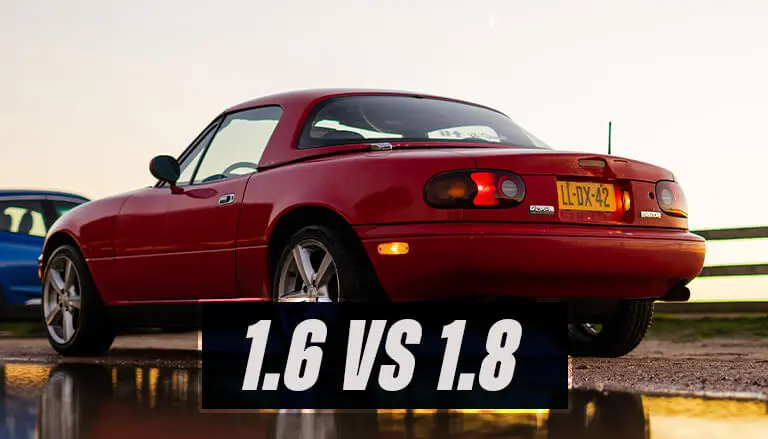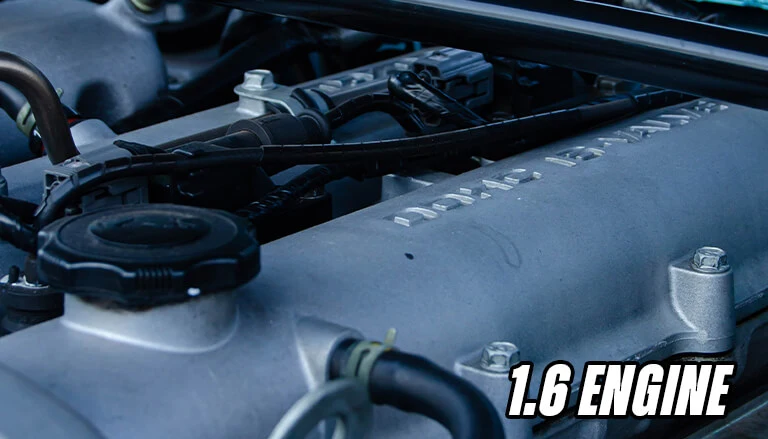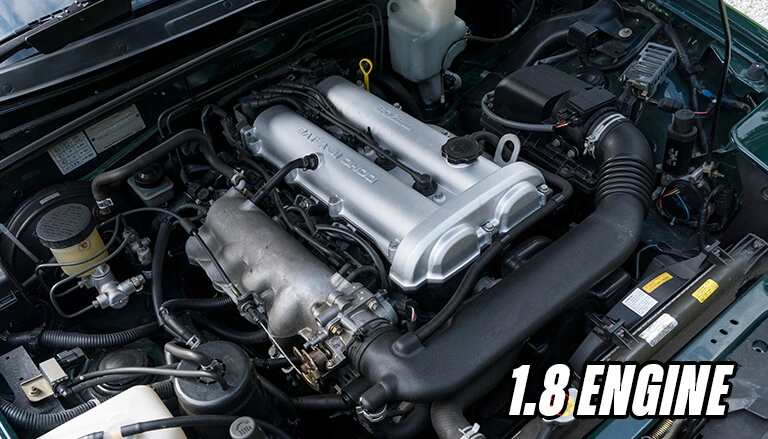As I opened eBay to browse first-generation MX-5 Miatas, I encountered a familiar problem. Do I choose the 1.6 (NA6) engine, or the 1.8 (NA8)?
Now, a standard Mk1 MX-5 is never going to be the quickest car on the road. But there are some differences between these engines that you need to be aware of if you’re looking to become an NA Miata owner.
In this article, I’ll cover the differences between the two and help you make an informed decision about which engine to go for.

Which is better: 1.6 or 1.8?
While the 1.8 Miata boasts more horsepower (129-133 HP) and better chassis rigidity than the 1.6 Miata, it is only marginally faster. This is due to the extra chassis bracing and more features resulting in a heavier weight on the 1.8 versions.
Having tested out both versions of the NA Miata, I honestly can’t feel much of a difference between them. The 1.6 feels revvier and more ready to go: probably because of its lighter chassis weight and lightened flywheel.
While the 1.8 is quicker on paper, the 4-speed automatic transmission version that I test-drove fell under my expectations. It did feel marginally quicker when starting off. It was really nice having air conditioning, too – but I find the stripped-back Miata experience much more appealing.
Plus, they both have pop-up headlights. That’s all that really matters, right?
As with most decisions, it mostly comes down to personal preference: so it’s important to test out both options (if you can) and go with what your heart is telling you.

The 1.6 engine: pros and cons
According to Mazda, the 1.6 engine used in the early first-generation Miata would reach 0-60 mph in 8.6 seconds. Sure, this engine was never going to break any records. But it continues to be the most popular platform for both stock enjoyment and modification in the Miata community.
Pro: It’s easy to modify
Engines used in MX-5 Miatas are often thought to be over-engineered. They’re ready and willing to take on more power!
That’s why the 1.6 engine continues to provide a reliable and affordable platform to turbocharge or supercharge your NA MX-5 Miata.
While the engine is good for some extra power, you will probably need to swap out the stock differential, brakes and clutch for beefier alternatives. This will ensure that your turbo Miata build remains reliable, safe and hassle-free for years to come.
Don’t want to go that far? No problem. It’s easy to attach a cold air intake, swap out the HT leads or upgrade the intake manifold on a standard 1.6 Miata engine for smaller power gains.
With the Mazda Miata being the most popular roadster ever made, there’s no shortage of OEM and aftermarket parts out there.
Whatever your taste, you can be confident that you will find the right parts in a price range that suits you. They’re also really easy to work on!
Pro: It’s lighter
You know what they say: a bigger engine makes you faster in a straight line. But a lighter weight makes you faster everywhere.
NA Miatas equipped with the stock 1.6L engine weigh in at a total of 950 kg (2094 lbs). That’s super light for a modern motor vehicle. In comparison, the 1.8L version weighs in at 990 kg (2183 lbs).
The MX-5 Miata’s low chassis weight means better handling and acceleration on the road. While you might not necessarily be quickest off the line, the NA really comes into its own on twisty backroads and hilltop drives.
Less stress on suspension components, better handling and much easier to lift up in the air and work on: the 1.6 NA Miata will always be the lightweight roadster built for car enthusiasts.
Pro: It’s cheaper
NA MX-5 Miatas equipped with the 1.6-litre engine are the most common version. You can usually find an abundance of them on online marketplaces and specialist dealer lots.
Because the 1.6 engines are more common than the 1.8s, they tend to be more affordable. These models also lack some of the additional safety features and chassis bracing that accompanies the 1.8s, so they command a lower price.
So if you’re on a budget, you’ll probably want a 1.6. Take advantage of a bargain – you won’t regret it!
Con: It’s slower
This one should come as no surprise…
Indeed, the 1.6 engine is slower than the 1.8. This is because the 1.6 has a smaller displacement than the 1.8 engine. It can’t use as much air or fuel in the combustion process, meaning it generates less power.
A stock 1.6-litre engine is good for around 115 HP. In comparison, the 1.8-litre makes 129 HP. While some of that extra power is offset by the heavier chassis weight of the 1.8, it’s still a quicker engine on paper.
Got a need for speed? If that extra horsepower is tempting you, you’ll be better off with the 1.8.
Con: It lacks upgrades
Early versions of the 1.6 MX-5 Miata (pre-1994) lacked features like air conditioning, stereos and even power steering. While these features were added post-1994 to the 1.6, it still falls short of the 1.8 version for a number of reasons.
As standard, NA Miatas with 1.8 engines were equipped with a better differential, bigger brakes, a stronger clutch and more chassis bracing than their 1.6 counterparts.
Thus, in comparison to the 1.8, the 1.6 NAs can feel a bit floppier and less able to handle extra power. For most, though, it doesn’t make a huge difference. The 1.6 is still more than happy to take whatever a driver throws at it.

The 1.8 engine: pros and cons
According to Mazda, the 1.8-litre versions of the NA MX-5 Miata have up to 129 HP from the factory. The 1.8 models were produced from 1994 to 1997 at a smaller volume than the more common 1.6 models.
Pro: It’s quicker
It’s true: there’s no replacement for displacement. The 1.8-litre engine is faster than the 1.6-litre engine due to its bigger displacement and ability to make more power.
A greater engine displacement means that more air and fuel can be consumed by the engine and combined with a spark to generate power.
In real terms, the 1.8 is good for generating around 14 extra horsepower when compared to its 1.6-litre brother. A small improvement, sure, but enough to make a difference.
Some 1.8 engines are also known to have a better flowing head design from the factory, meaning that your engine will breathe better. An engine that can efficiently manage the flow of air is a happier and more powerful engine.
Pro: It has upgrades
A better differential, enhanced chassis bracing and bigger brakes. That’s just a few extra ingredients added to the NA Miata’s winning formula with the 1.8 version.
The additional chassis bracing results in a tighter feel with much more control on corners. Braces on the subframes and in the cockpit are designed to stiffen the car while also providing better side impact protection in the event of an accident.
The stronger differential and bigger brakes are much more forgiving when being thrown around a track or made to take on additional power from a turbo or supercharger.
With the 1.8, you get more leeway and some room to modify without having to swap out so many components. Likewise, if you want to keep it stock, you’ll benefit from the OEM upgrades added by Mazda. It’s a win-win!
Con: It’s more expensive
With fewer 1.8-litre NAs produced by Mazda during the 90s, there are less examples available on our roads today. With less on the market, you’re likely to pay higher prices to acquire one.
Some will say that it is worth paying the premium price for a 1.8 because of its upgrades and ‘newness’. Others will tell you that it’s not worth it and that you get an almost identical experience in a 1.6.
Ultimately, it’s up to you. If you’re on a strict budget, the 1.6 is probably for you. If money is no object and you’re keen for a bit of extra power, opt for the 1.8. Whichever you choose, you’ll still get the full Miata experience.
Con: It’s rarer
Sure, sometimes rarity is cool. But when you’re looking to replace parts or modify an engine, you want as many options to choose from as possible.
Due to the 1.8 Miatas being less common than 1.6s, it’s sometimes harder to find parts and replacements. Picture this: your motor has developed a knocking sound as a result of the previous owner putting no oil in the engine.
It can be difficult to find a 1.8 replacement engine for the NA. Even when you do find one, you can expect to pay a handsome sum for it.
Likewise, the availability of aftermarket parts for the 1.8 can be slim. On a brighter note, this is the best-selling roadster of all time: so you’ll be sure to find the part you need, eventually.
My verdict
Personally, I am inclined to lean toward an early 1.6 NA Miata. It’s cheaper, more readily available and equipped with enough power to do the job. Having tested out a 1.8, albeit an automatic, the power difference is barely noticeable for me.
Part of the fun of owning an MX-5 Miata is getting to work on it. With a 1.6, there’s no end to easy modifications that you can do to enhance the ride and appearance of the car.
Straight-line speed isn’t really my priority when it comes to roadsters. I’m a huge fan of one that can maintain speed and handle well through corners, which is why I’m so drawn to MX-5 Miatas.
Whichever you choose – 1.6 or 1.8 – both of these vehicles are still Miatas! They still possess that winning formula that makes the car so popular among enthusiasts. Whichever you choose, you’re sure to have a lot of fun with it.
As always, I’d recommend test-driving both models and seeing which works best for you.
FAQs
Which year Miatas have 1.8L engines?
NA MX-5 Miatas with 1.8-litre engines were produced by Mazda from 1994 to 1997. The first production run was from 94 to 95, with these models making a respectable 128 horsepower. Those produced in 97 and 98 made 133 horsepower from the factory.
How can you tell the difference between a 1.6 and a 1.8 NA Miata?
There are a few different ways that you can tell the difference between a 1.6 and a 1.8 Miata. Check out our full guide on how to tell the difference between a 1.6 and a 1.8 Miata.
You can easily tell by the writing on the cam cover of the engine. If the letters are raised, it’s a 1.8-litre engine. If the lettering is sunken into the cam cover, it’s a 1.6-litre engine.
Conclusion
So, there you have it. I hope that this article helped you to make a decision on which model will be best for you.
There are so many debates in the Miata community. Manual vs Automatic Miatas, turbo or supercharge, NA or NB…
Miata 1.6 or 1.8 – whichever you choose, you’ll still have a first-generation Miata, the car that started it all.
If you have any questions, feel free to drop them below. I’ll do my best to help!